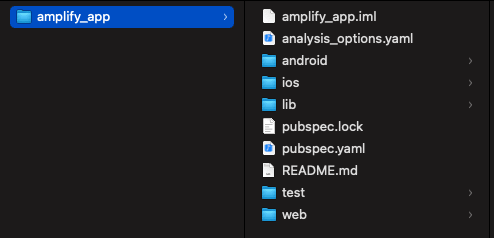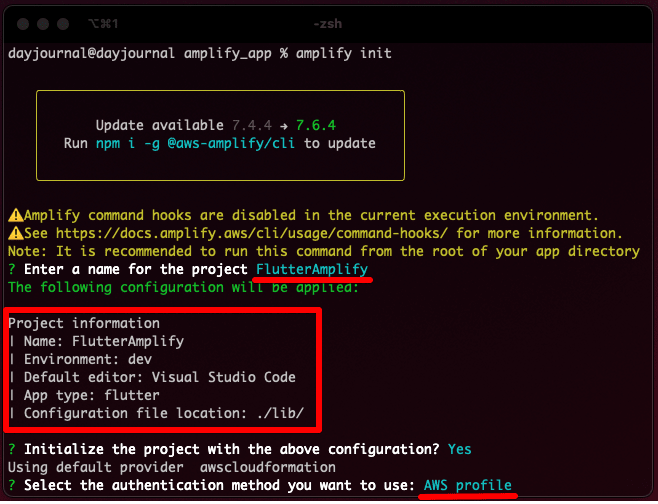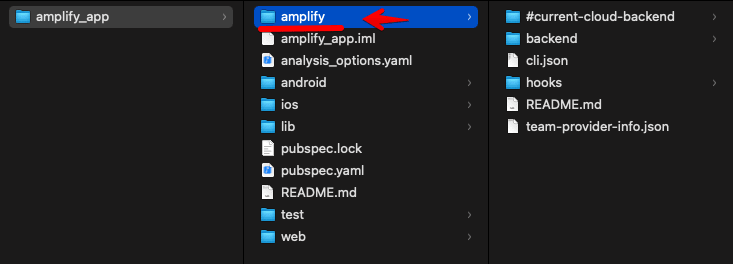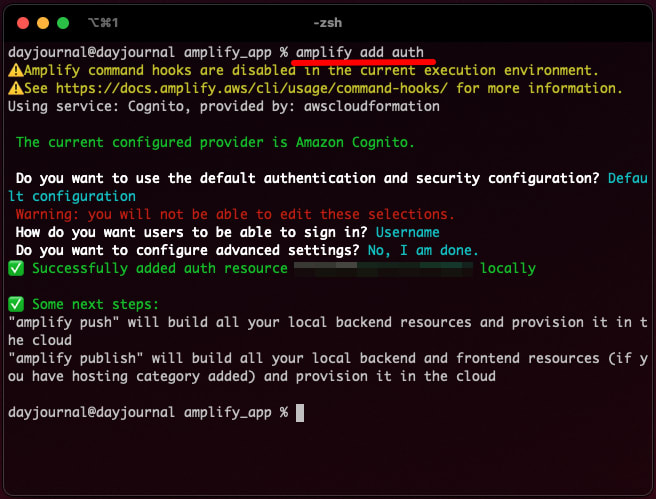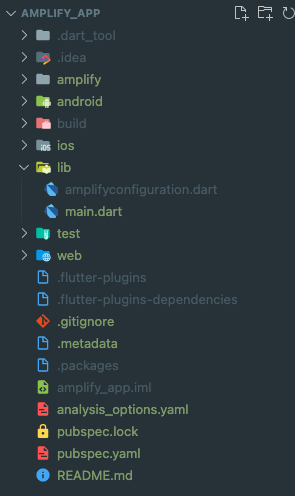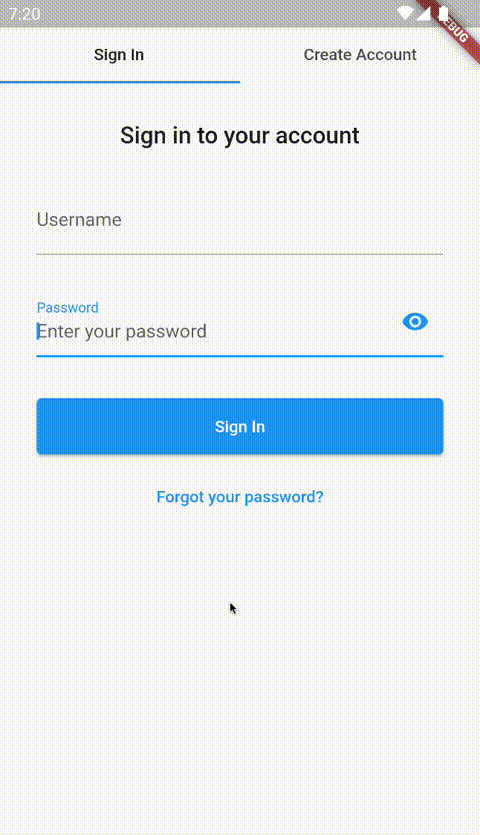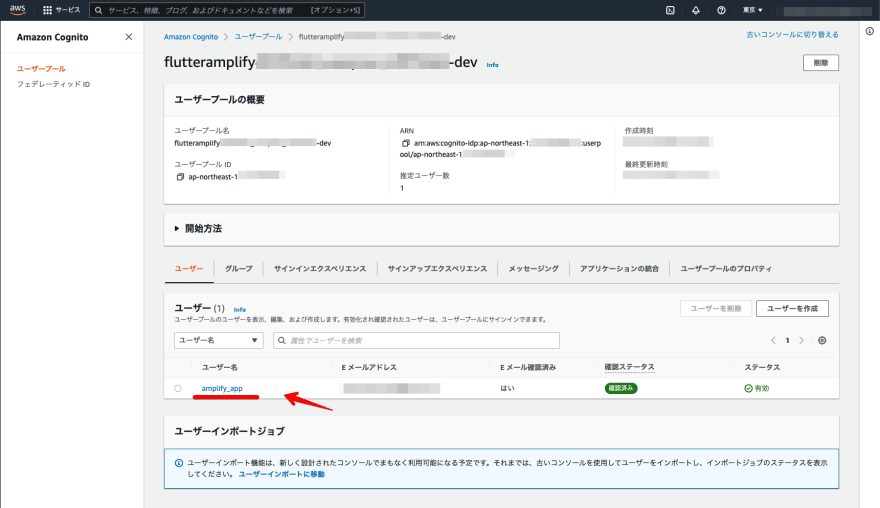This content originally appeared on DEV Community and was authored by Yasunori Kirimoto
I built a login function with AWS Amplify and Flutter 🎉
I built a login function using AWS Amplify, Amplify UI Components' amplify_authenticator, and Flutter!
Advance Preparation
- Preparing the Flutter environment
- Flutter #001 - Installation
- Flutter v2.8.0
- Dart v2.15.0
- Xcode v13.1
- Android SDK v32.0.0
- Android Studio v2020.3
- Visual Studio Code v1.63.0
- Flutter extension v3.29.0
- Preparing the AWS Amplify environment
- AWS Amplify #001 - Installation
- node v16.10.0
- npm v7.24.0
Creating a Flutter project
First, we need to create a Flutter project.
Flutter #002 - Building the Environment
flutter create amplify_app
This completes the creation of the Flutter project.
Setting up AWS Amplify
The next step is to configure AWS Amplify for Flutter and add authentication capabilities.
Configuring AWS Amplify for Flutter
AWS Amplify #006 - Building the environment [Flutter version]
amplify init
Add authentication
AWS Amplify #003 - Add Authentication
amplify add auth
amplify push
This completes the setup of AWS Amplify.
Configuring Flutter
Finally, we'll write the actual code for the login function.
Overall configuration
pubspec.yaml
name: amplify_app
description: A new Flutter project.
publish_to: 'none'
version: 1.0.0+1
environment:
sdk: '>=2.15.0 <3.0.0'
dependencies:
flutter:
sdk: flutter
cupertino_icons: ^1.0.2
amplify_auth_cognito: ^0.3.0-0
amplify_authenticator: ^0.1.0-0
amplify_flutter: ^0.3.0-0
dev_dependencies:
flutter_test:
sdk: flutter
flutter_lints: ^1.0.0
flutter:
uses-material-design: true
Install the Amplify UI Components package related to "amplify_authenticator."
amplify_auth_cognito: ^0.3.0-0
amplify_authenticator: ^0.1.0-0
amplify_flutter: ^0.3.0-0
/lib
main.dart
import 'package:amplify_auth_cognito/amplify_auth_cognito.dart';
import 'package:amplify_authenticator/amplify_authenticator.dart';
import 'package:amplify_flutter/amplify.dart';
import 'package:flutter/material.dart';
import 'amplifyconfiguration.dart';
void main() {
runApp(const MyApp());
}
class MyApp extends StatefulWidget {
const MyApp({Key? key}) : super(key: key);
@override
_MyAppState createState() => _MyAppState();
}
class _MyAppState extends State<MyApp> {
@override
void initState() {
super.initState();
_configureAmplify();
}
Future<void> _configureAmplify() async {
try {
await Amplify.addPlugin(AmplifyAuthCognito());
await Amplify.configure(amplifyconfig);
} on Exception catch (e) {
print('Could not configure Amplify: $e');
}
}
@override
Widget build(BuildContext context) {
return MaterialApp(
theme: ThemeData.light(),
darkTheme: ThemeData.dark(),
home: Authenticator(
child: const LoggedInScreen(),
),
);
}
}
class LoggedInScreen extends StatelessWidget {
const LoggedInScreen({Key? key}) : super(key: key);
@override
Widget build(BuildContext context) {
return Scaffold(
body: Center(
child: Column(
children: const [
Text('Logged In'),
SignOutButton(),
],
),
),
);
}
}
Load the AWS Amplify related things.
import 'package:amplify_auth_cognito/amplify_auth_cognito.dart';
import 'package:amplify_authenticator/amplify_authenticator.dart';
import 'package:amplify_flutter/amplify.dart';
import 'amplifyconfiguration.dart';
Set up the AWS Amplify authentication.
Future<void> _configureAmplify() async {
try {
await Amplify.addPlugin(AmplifyAuthCognito());
await Amplify.configure(amplifyconfig);
} on Exception catch (e) {
print('Could not configure Amplify: $e');
}
}
Configure the UI components.
@override
Widget build(BuildContext context) {
return MaterialApp(
theme: ThemeData.light(),
darkTheme: ThemeData.dark(),
home: Authenticator(
child: const LoggedInScreen(),
),
);
}
Configure the screen after login.
@override
Widget build(BuildContext context) {
return Scaffold(
body: Center(
child: Column(
children: const [
Text('Logged In'),
SignOutButton(),
],
),
),
);
}
/android/app
build.gradle
def localProperties = new Properties()
def localPropertiesFile = rootProject.file('local.properties')
if (localPropertiesFile.exists()) {
localPropertiesFile.withReader('UTF-8') { reader ->
localProperties.load(reader)
}
}
def flutterRoot = localProperties.getProperty('flutter.sdk')
if (flutterRoot == null) {
throw new GradleException("Flutter SDK not found. Define location with flutter.sdk in the local.properties file.")
}
def flutterVersionCode = localProperties.getProperty('flutter.versionCode')
if (flutterVersionCode == null) {
flutterVersionCode = '1'
}
def flutterVersionName = localProperties.getProperty('flutter.versionName')
if (flutterVersionName == null) {
flutterVersionName = '1.0'
}
apply plugin: 'com.android.application'
apply plugin: 'kotlin-android'
apply from: "$flutterRoot/packages/flutter_tools/gradle/flutter.gradle"
android {
compileSdkVersion flutter.compileSdkVersion
compileOptions {
sourceCompatibility JavaVersion.VERSION_1_8
targetCompatibility JavaVersion.VERSION_1_8
}
kotlinOptions {
jvmTarget = '1.8'
}
sourceSets {
main.java.srcDirs += 'src/main/kotlin'
}
defaultConfig {
// TODO: Specify your own unique Application ID (https://developer.android.com/studio/build/application-id.html).
applicationId "com.example.amplify_app"
minSdkVersion 21
targetSdkVersion flutter.targetSdkVersion
versionCode flutterVersionCode.toInteger()
versionName flutterVersionName
}
buildTypes {
release {
// TODO: Add your own signing config for the release build.
// Signing with the debug keys for now, so `flutter run --release` works.
signingConfig signingConfigs.debug
}
}
}
flutter {
source '../..'
}
dependencies {
implementation "org.jetbrains.kotlin:kotlin-stdlib-jdk7:$kotlin_version"
}
To display the amplify_authenticator on Android, you need to specify the Android SDK version, so select a fixed "minSdkVersion."
defaultConfig {
// TODO: Specify your own unique Application ID (https://developer.android.com/studio/build/application-id.html).
applicationId "com.example.amplify_app"
minSdkVersion 21
targetSdkVersion flutter.targetSdkVersion
versionCode flutterVersionCode.toInteger()
versionName flutterVersionName
}
Run "Run and Debug" in Visual Studio Code and log in after user registration.
Check to see if the user is registered in the AWS console.
I was able to build the login function with AWS Amplify and Flutter 👍
If you want to implement the login function in Flutter, Firebase is often used, but I was able to confirm that it can be implemented with AWS Amplify 💡
This content originally appeared on DEV Community and was authored by Yasunori Kirimoto
Yasunori Kirimoto | Sciencx (2021-12-22T12:03:23+00:00) Building a Login Function with AWS Amplify and Flutter. Retrieved from https://www.scien.cx/2021/12/22/building-a-login-function-with-aws-amplify-and-flutter/
Please log in to upload a file.
There are no updates yet.
Click the Upload button above to add an update.


